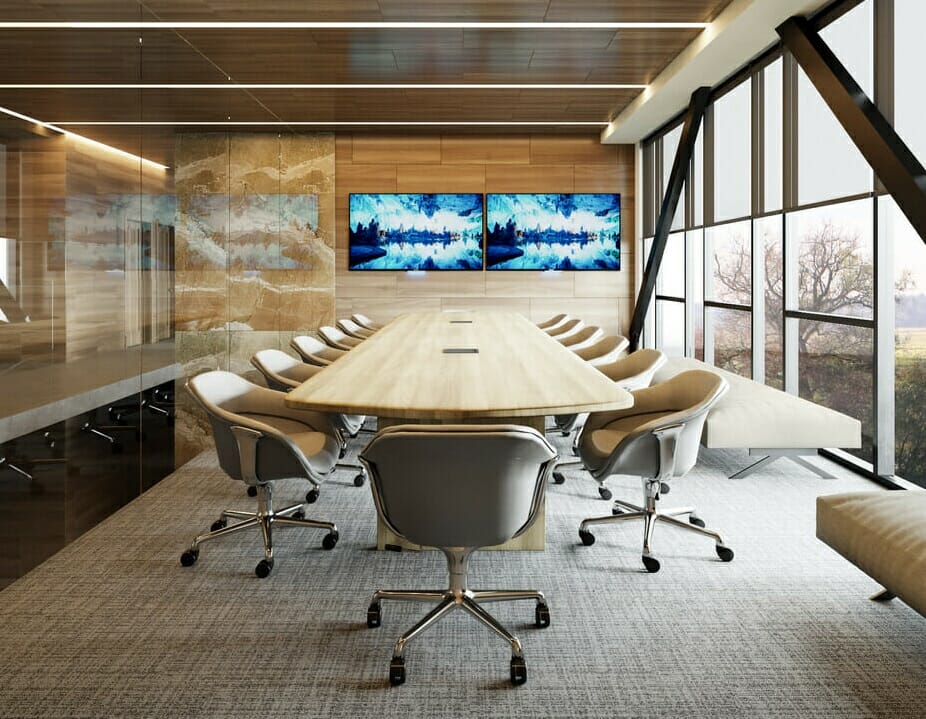Introduction
Corporate office interior design has evolved from being merely aesthetic to becoming a strategic tool for enhancing employee productivity, well-being, and overall business success. As organizations increasingly invest in creating appealing and functional workspaces, it becomes crucial to measure the Return on Investment (ROI) of these design initiatives. In this article, we will explore the multifaceted aspects of measuring the ROI of corporate office interior design, providing insights into both tangible and intangible returns that such investments can yield.
Understanding the ROI of Office Interior Design
Before delving into the metrics and methods for measuring the ROI of office interior design, it’s essential to comprehend what constitutes a return on this type of investment. ROI in office interior design can be categorized into both quantifiable, tangible returns and intangible, qualitative benefits:
- Tangible Returns
Tangible returns are those that can be measured in financial terms. These are often the primary focus when evaluating ROI:
1.1. Cost Savings
Effective office design can lead to cost savings in several ways, such as optimizing space utilization, reducing energy consumption through efficient lighting and HVAC systems, and minimizing maintenance expenses. For instance, a well-designed open office layout might require less square footage per employee, reducing real estate costs.
1.2. Increased Productivity
Productivity gains are among the most significant tangible returns on office interior design investments. A well-designed workspace can minimize distractions, enhance comfort, and promote efficient workflows, ultimately leading to increased output per employee.
1.3. Recruitment and Retention
Attractive and functional office spaces can aid in attracting top talent and retaining existing employees. A high-quality office environment can be a competitive advantage in a tight labor market, reducing recruitment and onboarding costs.
1.4. Health and Well-Being
Investing in employee well-being can translate into quantifiable returns. Healthier, happier employees tend to take fewer sick days, reducing absenteeism costs. Additionally, well-designed office spaces can foster physical activity, reducing healthcare expenses related to sedentary behavior.
1.5. Brand Perception
A well-designed office can positively impact how clients, partners, and potential investors perceive a company. This improved brand perception can lead to increased sales, partnerships, or investment opportunities, directly affecting the bottom line.
- Intangible Benefits
Intangible benefits are more challenging to quantify but can be equally valuable:
2.1. Employee Satisfaction
Employee satisfaction is a critical intangible benefit. A comfortable and visually appealing workspace can boost morale, leading to a happier, more engaged workforce. While it’s challenging to put a precise monetary value on employee satisfaction, its impact on overall business performance is undeniable.
2.2. Innovation and Creativity
A well-designed office environment can stimulate innovation and creativity, fostering an atmosphere where employees feel inspired to generate new ideas. These innovations may lead to new products, services, or processes that contribute to revenue growth.
2.3. Collaboration and Knowledge Sharing
Effective office design can facilitate collaboration and knowledge sharing among employees. While these outcomes are challenging to quantify directly, they can lead to improved problem-solving, faster decision-making, and better project outcomes.
2.4. Employee Retention
While recruitment costs can be measured directly, the value of retaining experienced employees with valuable institutional knowledge is often underestimated. High turnover can lead to disruption, lost productivity, and recruitment expenses, all of which impact the bottom line.
2.5. Talent Attraction
An aesthetically pleasing and functional office space can make a significant impression on potential job candidates. The ability to attract top talent can indirectly contribute to revenue growth through improved workforce capabilities.
Measuring the Tangible Returns
Now that we’ve outlined the various tangible and intangible returns associated with office interior design, let’s delve into specific methods for measuring the tangible returns:
- Cost Savings
1.1. Real Estate Costs: Compare the cost per square foot before and after the office redesign. Calculate savings if the redesign allowed for a reduction in leased space.
1.2. Energy Consumption: Measure energy consumption before and after implementing energy-efficient design elements, such as LED lighting and HVAC upgrades.
1.3. Maintenance Costs: Track maintenance expenses over time, comparing the costs before and after the design changes.
- Increased Productivity
2.1. Productivity Metrics: Utilize key performance indicators (KPIs) related to productivity, such as project completion times, to assess improvements.
2.2. Employee Output: Compare the output per employee before and after the redesign. Consider both quantitative and qualitative measures.
2.3. Surveys and Feedback: Conduct employee surveys to gauge perceived changes in productivity and comfort.
- Recruitment and Retention
3.1. Recruitment Costs: Calculate the cost savings from reduced recruitment efforts due to a more appealing workspace.
3.2. Retention Rates: Track employee turnover rates before and after the redesign to determine if retention has improved.
- Health and Well-Being
4.1. Absenteeism Rates: Monitor absenteeism rates to assess whether a healthier workplace has reduced the number of sick days taken by employees.
4.2. Healthcare Expenses: Analyze changes in healthcare costs associated with lifestyle-related health issues that may be influenced by the office environment.
- Brand Perception
5.1. Client Feedback: Collect feedback from clients, partners, and investors to assess whether the improved office space positively impacts their perception of the company.
Measuring the Intangible Benefits
While intangible benefits are challenging to measure precisely, there are methods to gauge their impact:
- Employee Satisfaction
1.1. Employee Surveys: Conduct regular surveys to measure employee satisfaction with the office environment and its impact on their work experience.
1.2. Turnover and Retention: Analyze employee turnover and retention rates as indicators of overall satisfaction.
- Innovation and Creativity
2.1. Idea Generation: Track the number of new ideas or innovations generated by employees and assess their impact on the business.
2.2. Project Outcomes: Evaluate project outcomes for signs of improved problem-solving or creative solutions.
- Collaboration and Knowledge Sharing
3.1. Collaboration Metrics: Assess collaboration metrics, such as the frequency of cross-functional team meetings and the use of shared digital tools.
3.2. Knowledge Sharing: Measure the sharing of knowledge and expertise among employees using collaboration platforms or other methods.
- Employee Retention
4.1. Turnover Costs: Calculate the costs associated with turnover, including recruitment, onboarding, and training expenses.
4.2. Institutional Knowledge: Consider the value of retaining employees with extensive institutional knowledge, which can lead to cost savings and better decision-making.
- Talent Attraction
5.1. Candidate Feedback: Gather feedback from job candidates about their perception of the office space during the recruitment process.
5.2. Recruitment Success: Measure the success rate of recruiting top talent and compare it to pre-redesign recruitment efforts.
Conclusion
Measuring the ROI of corporate office interior design involves a nuanced assessment of both tangible and intangible returns. While quantifiable metrics such as cost savings and increased productivity are essential, intangible benefits like employee satisfaction, innovation, and brand perception also play a crucial role in overall business success. Therefore, organizations should adopt a holistic approach to evaluating the impact of office design investments, recognizing that the true ROI encompasses a wide range of factors that contribute to long-term growth and competitiveness. By doing so, businesses can make informed decisions about office interior design that align with their strategic goals and priorities.




